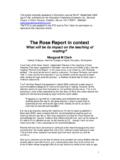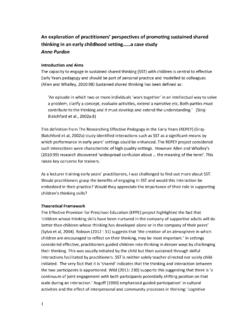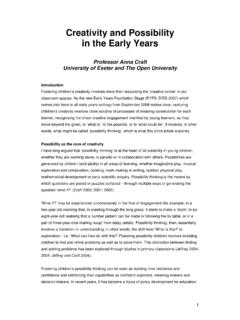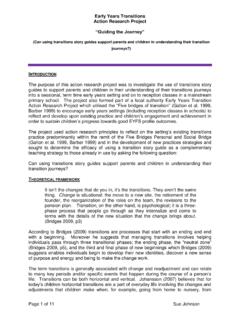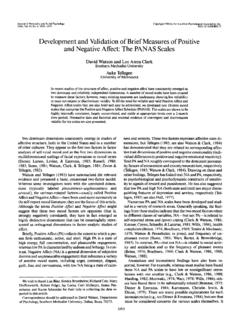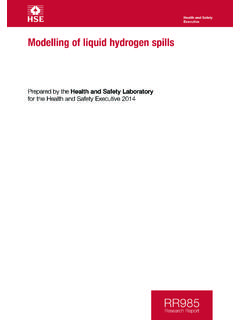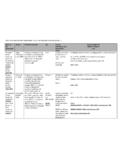Transcription of The Rose Report in context - TACTYC
1 This article originally appeared in Education Journal , September 2006 ( ), published by the Education Publishing Company Ltd., Devonia House, 4 Union Terrace, Crediton, Devon, EX17 B3DY. Website: TACTYC is very grateful to the EPC and to Prof. Clark for permission to reproduce this important article. The rose Report in context What will be its impact on the teaching of reading? Margaret M Clark Visiting Professor, Newman College of Higher Education, Birmingham A summary of the rose Report , Independent Review of the Teaching of Early Reading: final Report , appeared in Education Journal (Issue 94 2006, ) under the heading Phonics Final Report . In the same issue, in an article by Colin Richards entitled, This could be the end of teacher autonomy , Professor Richards comments: Well in a few months time teachers of young children could be required to teach initial reading through synthetic phonics a method not dissimilar to those used in Victorian classrooms.
2 The Final rose Report that appeared in March 2006 contained a wide range of recommendations designed to improve the teaching of reading. However, all the attention seems to have been focussed on the synthetic phonics issue. This is not surprising in view of the statements by the Secretary of State who commissioned the Report and the fact that already by page three the Report states: Engaging young children in interesting and worthwhile pre-reading activities paves the way for the great majority to make a good start on systematic phonic work by the age of five. Indeed, for some, an earlier start may be possible and desirable. It is not surprising that, among the reactions to the interim Report (published in December 2005), were concerns that the recommendations could be seen as claiming that one size fits all. But I was pleased to see that the rose Report did acknowledge the research evidence that children benefit from learning the names of the letters of the alphabet as well as the sounds ( ) though I have not seen reference to that in any comments on the recommendations.
3 Parents will have been concerned or confused at the mixed messages they were receiving from the media about their role in their children s early learning to read. This at a time when research has shown just how much parents can and do contribute. Among my concerns are the lack of reference to provision for young children who are already able to read with fluency and understanding when they enter school and those children whose language difficulties may focus on phonics at too early an age. 1 This could be a stumbling block to their learning. I am not sure that all reading specialists would agree with the following: An early start on systematic phonic work is especially important for those children who do not have the advantages of strong support for literacy at home. ( ) Many young children now entering school are already more computer-literate than their teachers in this age of digital literacy. This is a something would should be taken into account when planning the curriculum for the Foundation Stage, for it deserves more attention than it appears to have received in this Report (see Popular Culture, New Media and Digital Literacy in Early Childhood ed.)
4 J. Marsh, 2005). Why in the United Kingdom, and in England in particular, is it considered to be progress to introduce children to reading, and especially phonics, so early and so long before the teaching of reading takes place in most other countries? Surely there is a case to be made for broadening the curriculum and for delaying the teaching of reading. This would make such instruction less time-consuming as a consequence of the children s greater maturity and better-developed listening skills. I was aware that, in parallel with the rose inquiry, the DfES had commissioned A Systematic Review of the Research Literature on the Use of Phonics in the Teaching of Reading and Spelling by the Universities of York and Sheffield. This Report was submitted in late 2005 and appeared in early 2006 (Torgerson, Brooks and Hall 2006). I was therefore surprised to find that it did not appear on the reference list of the rose Report .
5 From the pronouncements of some politicians and others, the impression has been given that an injection of synthetic phonics first, fast and only as soon as children enter school, will solve all reading problems. Some of the invective has been reminiscent of the hype that surrounded the introduction of ita (the initial teaching alphabet) over 40 years ago. In the 1960s, the focus of much of the funded research was on beginning reading. The solution to all the problems was then thought to lie with ita, which for a time swept through whole local authorities, then later disappeared with little trace. Has synthetic phonics now taken the place of ita? In 1975, the Bullock Report (A Language for Life, 1975) took a much wider, more considered approach, emphasising the importance of a whole-school policy for the teaching of reading in secondary as well as primary schools. In 1976, the Report of my study, Young Fluent Readers was published.
6 In it I considered the strengths of these fluent readers and also their weaknesses, despite which they managed to be successful at such a young age and continued to do well in school, thereby challenging some cherished beliefs. Rhona Stainthrop and Diana Hughes have undertaken a further such study modelled on my earlier research since the introduction of the national curriculum. I was therefore very surprised and concerned when I became aware of the Government s solution to the scale of illiteracy in this country, or at least the failure in England to reach the hoped-for targets in literacy by the end of Key Stage 2 in primary school. Background to the rose Inquiry On 22 June 2005 the then Secretary of State for Education, Ruth Kelly, wrote to Jim rose , who had agreed to her request to lead an independent review of best practice in the teaching of early reading and the range of strategies to best support children 2who have fallen behind.
7 In her letter to Jim rose , she set out three points she wished to be considered as follows: 1. What our expectations of best practice should be in the teaching of early reading and synthetic phonics for primary schools and early years settings, including both the content and the pace of teaching. 2. How this relates to the development of the birth-to-five framework and the ongoing development and renewal of the National Literacy Framework for teaching. 3. What range of provision best supports children with significant literacy difficulties and enables them to catch up with their peers, and the relationship of such targeted intervention programmes with synthetic phonics teaching. (Kelly 2005) Jim rose was asked to provide an interim Report by November 2005 with his full Report early in 2006. The interim Report was available by December 2005 and already Ruth Kelly was making it clear that she was fully in support of the findings, which recommended that a systematic, direct teaching of synthetic phonics should be the first strategy taught to all children learning to read, introduced by the age of five.
8 The decision to establish this inquiry was stimulated by the Report of the all-party House of Commons Education and Skills Teaching Children to Read (published in April 2005). The publicity from the media and politicians surrounding that Report had as its main focus phonics, more particularly synthetic phonics. Much of the oral evidence presented to the Committee was from proponents of synthetic phonics, several of them with a commercial interest in programmes for schools (such as Ruth Miskin and Sue Lloyd). Rhona Johnston was questioned on the same day ( ) on evidence from her research undertaken in primary schools in Clackmannanshire, a small county in Scotland. Suddenly Clackmannanshire was discovered in England, though few references identified the precise nature of these researches. The Clackmannanshire Research In that research, the comparison was not between phonics and no phonics, but different amounts, speeds and types of phonics programmes within an early intervention programme.
9 Frequent reference was made in the media to the spectacular results from that research and in particular the results from the boys. This is not the place to undertake a critical evaluation of these researches. However, it should be noted that the more spectacular results were in the children s word recognition skills, rather than in their understanding. By Primary 7 (the end of primary school in Scotland) the group taught initially by synthetic phonics were cited as reading 3 years 6 months ahead of chronological age, spelling was 1 year 8 months ahead. However, reading comprehension was only months ahead. Criticisms of the methodology of the research have been voiced and a number of articles have appeared from experts in Scotland drawing attention to the other aspects of the programme in these primary schools as the county was involved in an early intervention study with funding from the Scottish Executive.
10 Concerned that the hype was in danger of spreading from the media in England to Scotland, as the First Minister had become the most recent evangelist for synthetic phonics , Sue Ellis was interviewed for a leading article in TES Scotland on 2 September 2005 (by Elizabeth Buie). She expressed concern that one study which has had no external validation now appears to be dictating educational policy . She also expressed irritation that complex research is being converted into soundbites . In a further article in TES Scotland entitled Phonics is just the icing on the cake (TES Scotland 323 September 2005), she pointed out that the schools did not just do phonics, nor did the authority just give the schools a programme and tell them to get on with it. She undertook a careful analysis of what was entailed by the intervention in Clackmannshire, in addition to the comparison of the two types of phonics. In brief, there was a varied programme: nursery nurses were introduced into Primary 1, story bags; home-link teachers; homework clubs and nurture groups.
